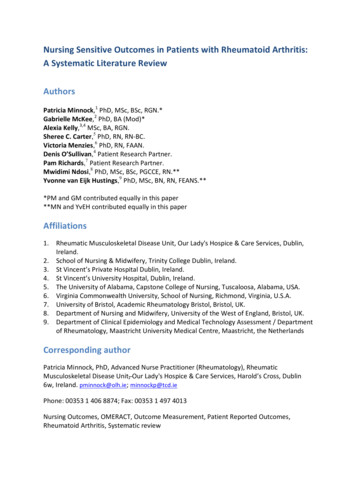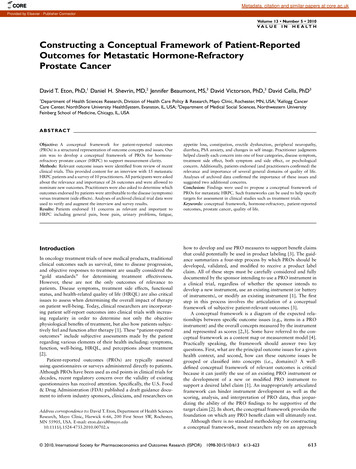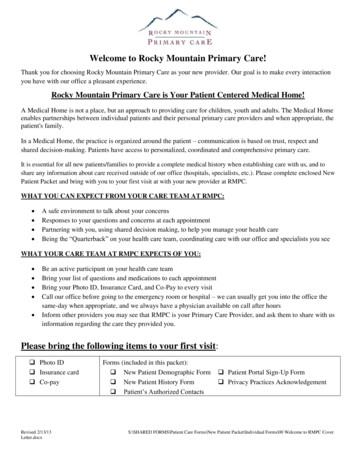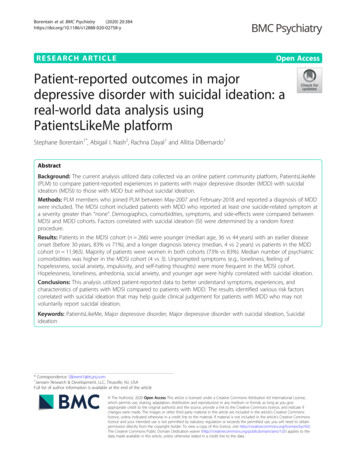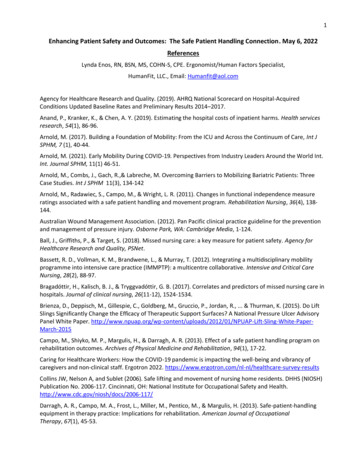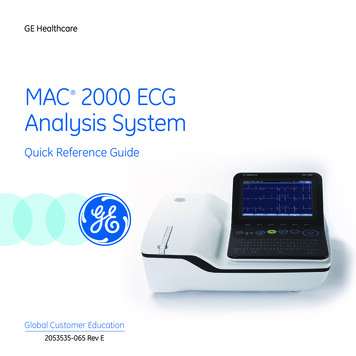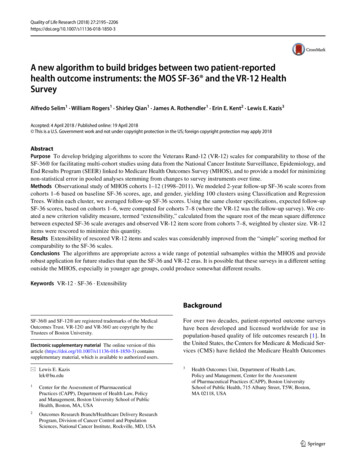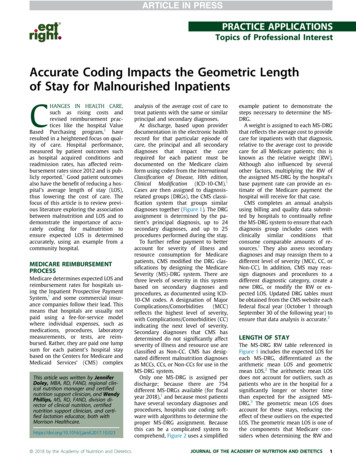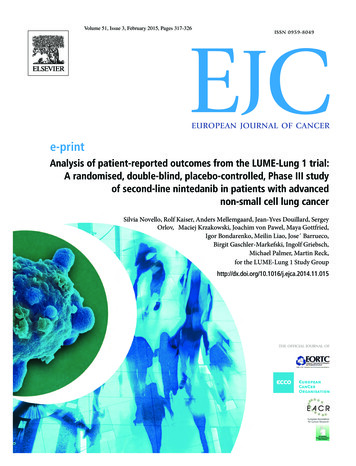
Transcription
1807 Cover.qxp Layout 1 15.11.13 13:44 Seite 1Volume 51, Issue 3, February 2015, Pages 317-326ISSN 0959-8049EJCEUROPEAN JOURNAL OF CANCERe-printAnalysis of patient-reported outcomes from the LUME-Lung 1 trial:A randomised, double-blind, placebo-controlled, Phase III studyof second-line nintedanib in patients with advancednon-small cell lung cancerSilvia Novello, Rolf Kaiser, Anders Mellemgaard, Jean-Yves Douillard, SergeyOrlov, Maciej Krzakowski, Joachim von Pawel, Maya Gottfried,Igor Bondarenko, Meilin Liao, Jose Barrueco,Birgit Gaschler-Markefski, Ingolf Griebsch,Michael Palmer, Martin Reck,for the LUME-Lung 1 Study HE OFFICIAL JOURNAL OF
European Journal of Cancer (2015) 51, 317– 326Available at www.sciencedirect.comScienceDirectjournal homepage: www.ejcancer.comAnalysis of patient-reported outcomes from the LUMELung 1 trial: A randomised, double-blind, placebocontrolled, Phase III study of second-line nintedanib inpatients with advanced non-small cell lung cancerSilvia Novello a, , Rolf Kaiser b, Anders Mellemgaard c, Jean-Yves Douillard d,Sergey Orlov e, Maciej Krzakowski f, Joachim von Pawel g, Maya Gottfried h,Igor Bondarenko i, Meilin Liao j, José Barrueco k, Birgit Gaschler-Markefski b,Ingolf Griebsch b, Michael Palmer l, Martin Reck m,1,for the LUME-Lung 1 Study GroupaDepartment of Oncology, University of Turin, ItalyBoehringer Ingelheim Pharma GmbH & Co. KG, Biberach, GermanycDepartment of Oncology, Herlev University Hospital, Copenhagen, DenmarkdDepartment of Medical Oncology, Centre René Gauducheau, Nantes, FranceeDepartment of Thoracic Oncology, St. Petersburg State Medical University, St. Petersburg, RussiafThe Maria Sklodowska-Curie Institute of Oncology, Warsaw, PolandgPneumology Clinic, Asklepios Fachkliniken, Gauting, GermanyhLung Cancer Unit, Meir Medical Center, Kfar Saba, IsraeliClinical Facility, Dnepropetrovsk Medical Academy, City Clinical Hospital #4, Dnepropetrovsk, UkrainejShanghai Chest Hospital, Shanghai, ChinakBoehringer Ingelheim Pharmaceuticals Inc., Ridgefield, CT, USAlKeele University, Keele, United KingdommDepartment of Thoracic Oncology, Lung Clinic Grosshansdorf, Grosshansdorf, GermanybReceived 3 September 2014; received in revised form 14 November 2014; accepted 17 November 2014Available online 17 December 2014KEYWORDSAnti-angiogenesisDocetaxelAbstract Introduction: The LUME-Lung 1 trial (NCT00805194; Study 1199.13) demonstrated a significant overall survival (OS) advantage for nintedanib plus docetaxel comparedwith placebo plus docetaxel as second-line therapy for patients with advanced non-small cell Corresponding author at: Department of Oncology, University of Turin, AOU San Luigi, Regione Gonzole 10, Orbassano (TO) 10043, Italy.1Tel.: 39 0119026978; fax: 39 0119038616.E-mail address: silvia.novello@unito.it (S. Novello).Member of the German Center for Lung Research (DZL), 150959-8049/ 2014 The Authors. Published by Elsevier Ltd.This is an open access article under the CC BY-NC-ND license ).
318NintedanibNon-small cell lungcancerQuality of lifeS. Novello et al. / European Journal of Cancer 51 (2015) 317–326lung cancer (NSCLC) and adenocarcinoma histology. Patient-reported outcomes (PROs) forsymptoms and health-related quality of life (QoL) are reported here.Methods: PROs were assessed at screening, on Day 1 of each 21-day treatment cycle, at theend of active treatment, and at the first follow-up visit. PRO instruments were the EuropeanOrganisation for Research and Treatment of Cancer Quality of Life Questionnaire C30 andLung Cancer-13 supplement, and the EuroQol disease-generic questionnaire (EQ-5D andEQ-VAS). Analyses of PRO items for lung cancer-specific symptoms of cough, dyspnoeaand pain were prespecified.Results: Rates of questionnaire completion were high. There was no significant difference intime to deterioration of global health status/QoL, or symptoms of cough, dyspnoea or pain,between the treatment groups for both the overall study population and the adenocarcinomapopulation. Time to deterioration of some gastrointestinal events was shorter with nintedanibversus placebo. Longitudinal analysis for the adenocarcinoma population showed comparablechanges between the groups in symptom scores over time, with numerical differences in favourof nintedanib for cough and pain scales, and significant reductions in some pain items withnintedanib versus placebo. There was no statistically significant difference in EQ-5D or EQVAS between the groups.Conclusion: The significant OS benefit observed with the addition of nintedanib to docetaxeltherapy was achieved with no detrimental effect on patient self-reported QoL.2014 The Authors. Published by Elsevier Ltd. This is an open access article under the CCBY-NC-ND license ).1. IntroductionThe number of approved second-line treatmentoptions for non-small cell lung cancer (NSCLC) remainslimited [1], and some options are restricted to patientswith tumours of a specific histology or molecular profile[2,3]. Newer agents—such as crizotinib, and where available, afatinib, ceritinib and gefitinib—are only indicatedfor those patients with oncogene-dependent tumours [4–7]. Currently approved oncogene-independent optionsinclude the cytotoxics docetaxel and pemetrexed, butthe survival benefit associated with these two agents ismodest [8,9], and pemetrexed is limited to patients withnon-squamous histology [10]. Erlotinib is also indicatedas second-line therapy irrespective of epidermal growthfactor receptor (EGFR) mutational status [11].Thus there remains a need for additional effective,well-tolerated second-line treatment options with wideapplication for relapsed/refractory NSCLC. Anti-angiogenic agents have been intensely investigated as potential new treatment options. Angiogenesis is critical forthe growth, progression and metastasis of many solidtumour types, and so it represents a fundamental targetfor cancer therapy [12,13]. Yet several clinical trials inNSCLC with different anti-angiogenic tyrosine kinaseinhibitors have failed to show an overall survival (OS)benefit [14]. To date, first-line bevacizumab remainsthe only approved anti-angiogenic treatment in the therapeutic armamentarium for advanced NSCLC.Nintedanib (formerly called BIBF 1120) is a novel,potent, oral, small-molecule angiokinase inhibitor thattargets three receptor classes involved in angiogenesis:vascular endothelial growth factor receptors (VEGFR)1–3, platelet-derived growth factor receptors (PDGFR)a/b and fibroblast growth factor receptors (FGFR)[15]. In a recent large-scale, Phase III, randomised trial(LUME-Lung 1; NCT00805194; Study 1199.13), second-line treatment with nintedanib plus docetaxel significantly improved progression-free survival (PFS) versusplacebo plus docetaxel (primary end-point) in the overall population of patients with advanced NSCLC (median PFS 3.4 versus 2.7 months [hazard ratio [HR] 0.79,95% confidence interval [CI]: 0.68–0.92, p 0.0019])and in prespecified populations of patients with adenocarcinoma histology (HR 0.77, 95% CI: 0.62–0.96,p 0 0193) and with adenocarcinoma histology andpoor prognosis (defined as progression within 9 monthsof starting prior first-line therapy) (median PFS 3.6 versus 1.5 months [HR 0.63, 95% CI: 0.48–0.83,p 0 0008]) [16]. In the hierarchical analysis, nintedanibplus docetaxel also significantly improved OS versus placebo plus docetaxel (secondary end-point) in the population with adenocarcinoma histology and poorprognosis (median OS 10.9 versus 7.9 months [HR0.75, 95% CI: 0.60–0.92; p 0.0073]) and the adenocarcinoma population (median OS 12.6 versus 10.3 months[HR 0.83, 95% CI: 0.70–0.99; p 0.0359]), but not in theoverall population [16].The extension of OS with nintedanib in the LUMELung 1 trial is notable because no study in the preceding decade had shown an OS benefit with second-linetreatment of advanced NSCLC. However, minimisingadverse events and maintaining patient quality of life(QoL) are also important goals in the second-line setting, where the scope for extension of survival is inany case limited [17–19]. The LUME-Lung 1 studyused patient-reported outcomes (PROs) as secondaryend-points to assess patients’ subjective perception oftheir symptom burden and health-related QoL to supplement the objective measures of efficacy and safety.
S. Novello et al. / European Journal of Cancer 51 (2015) 317–326The PROs from the LUME-Lung-1 trial are reportedhere.319(Question Q1 on the QLQ-LC13); dyspnoea (compositeof Q3–5 on the QLQ-LC13); and pain (composite of Q9and Q19 on the QLQ-C30).2. Patients and methods2.3. Scoring of the scales/items2.1. Study designLUME-Lung 1 was a randomised, placebo-controlled Phase III trial conducted at 211 centres across27 countries [16]. Eligible patients were adults with confirmed stage III/IV (according to the American JointCommittee on Cancers) recurrent NSCLC (all histologies) who had received one previous chemotherapy regimen and had an Eastern Cooperative Oncology Group(ECOG) performance status of 0 or 1. Patients were randomised (1:1) to receive docetaxel (75 mg/m2 on Day 1)plus nintedanib (200 mg twice daily on Days 2–21) ordocetaxel plus placebo in a 21-day treatment cycle. Randomisation was stratified by ECOG performance status(0 versus 1), previous bevacizumab treatment (yes versusno), histology (squamous versus non-squamous) and thepresence of brain metastases (yes versus no). Full detailsof the study design and methodology have been reportedpreviously [16].2.2. Patient-reported outcome measuresPROs were assessed at the screening visit, on Day 1of each 21-day treatment cycle, at the end of active treatment (EOT) and at the first follow-up visit. The questionnaires were completed by patients before seeingthe investigator, and before they were provided withany new information about their disease status, to avoidinfluencing responses.PRO instruments consisted of the 30-item EuropeanOrganisation for Research and Treatment of Cancer(EORTC) Core Quality of Life Questionnaire (QLQC30) [20]; its 13-item, lung cancer-specific supplement(QLQ-LC13) [21]; and the EuroQol disease-genericquestionnaire, comprising the EQ-5D overall utilityand EQ-visual analogue scale (VAS) [22]. EQ-5D utilityscores were calculated for each subject at each visit fromthe five-item scores using United Kingdom (UK) orBelgium data preference weightings [23].The QLQ-C30 incorporates both multi-items scalesand single-item measures, which include one globalhealth status/QoL scale, five functional scales, threesymptoms scales and six single items to assess dyspnoea,insomnia, appetite loss, constipation, diarrhoea andfinancial difficulties [20]. The QLQ-LC13 incorporatesone multi-item scale to assess dyspnoea, and a seriesof single items to assess pain, coughing, sore mouth,dysphagia, peripheral neuropathy, alopecia andhaemoptysis [21]. The analysis plan included evaluationof the effects of study treatment on prespecified lungcancer-specific symptoms of interest, which were coughThe EORTC questionnaire scales/items followed theEORTC scoring algorithm [24]. To aid interpretation,a linear transformation was applied to standardise theraw score for each scale/item to a range from 0 to 100.For the global health status/QoL scale and functionalscales, a value of 100 was equivalent to the best possiblescore and 0 to the worst possible score. For the symptom scales and symptom items, 100 was equivalent tothe highest burden of symptoms and 0 to the lowest burden. Completed questionnaires with missing data werehandled in line with EORTC guidelines, including theexception for the dyspnoea composite for which all threeresponses were required for an individual’s score to beused [24].2.4. Statistical analysesAnalyses were performed for adenocarcinomapatients with a time since start of first-line therapy torandomisation into this study 9 months, for the population of patients with adenocarcinoma histology, andthe overall population (all histologies) in a hierarchicalorder, as prespecified for the analysis of OS [16].Time to deterioration (TTD) in PROs was measuredfrom randomisation to first appearance of a minimalclinically important difference in the score, defined asP10-point change lower (for global health status/QoLand functional scales) or higher (for symptom scalesand items) [25]. TTD was analysed using a log-rank teststratified by the four stratification factors. A stratifiedCox proportional hazards model was used to estimatethe HRs and CIs of TTD. Patients without documentedPRO item deterioration were censored at the time of thepatient’s last PRO assessment.Changes in PROs over the duration of the medianfollow-up period were assessed using longitudinal models. These were mixed-effects growth curve models withthe average profile over time for each PRO end-pointdescribed using a piecewise linear model. A mean scoreper patient for each PRO was calculated from the areaunder the estimated growth curve (AUC) up to the median follow-up time. Treatment group mean scores werethen derived from the patient scores. The treatmenteffect was estimated as the average difference betweenthe treatment group scores, together with the 95% CIsand associated p-values based on a t-statistic withdegrees of freedom calculated using the Kenward–Rogermethod [26].Potential correlation between missing PRO data andoutcome variables was assessed using Kendall’s tau
320S. Novello et al. / European Journal of Cancer 51 (2015) 317–326statistic. The potential effect of missing PRO data tointroduce bias was assessed in sensitivity analyses usingjoint models, which consisted of the longitudinal modeland a time-to-event variable representing the withdrawalprocess. Time to last PRO assessment was used as thetime-to-event variable, and it was assumed to have aWeibull distribution.3. Results3.1. PatientsA total of 1773 patients were screened, of whom 1314were eligible and randomised to study treatment (655 tonintedanib plus docetaxel [322 with adenocarcinoma]and 659 to placebo plus docetaxel [336 with adenocarcinoma]) [16]. Patient demographics and baseline clinicalcharacteristics were well balanced across the treatmentarms for both the overall population and the prespecified population of patients with adenocarcinoma [16].More than 80% of patients included in the overallpopulation completed the EORTC QLQ-C30/LC13and EQ-5D over the first 10 courses of study treatmentwith comparable proportions of responders between thetwo treatment arms (Fig. 1). Approximately 70% ofpatients completed the QLQ-C30 at the EOT visit. Similar numbers of responses were also achieved for patientswith adenocarcinoma.3.2. Baseline patient-reported outcomesIn the overall population, mean global health status/QoL at baseline was relatively high, indicating reasonable levels of QoL, with comparable scores for the10090Questionnaires completed 7643Treatment courseNumber of expected responsesNintedanib plus docetaxel655Placebo plus docetaxel659654658595596Nintedanib plus docetaxelPlacebo plus 7EORTC QLQ-C30 European Organisation for Research and Treatment of Cancer Core Quality of Life Questionnaire, 30 items;EOT end of treatment; Sc screening.Fig. 1. Patient compliance with EORTC QLQ-C30 in overall population.Table 1Time to deterioration of patient-reported global health status/QoL and symptom scales/items.Hazard ratio* (95% ts with adenocarcinoma andtime since start of first-line therapy 9 months0.95 (0.83–1.10)0.86 (0.71–1.05)0.90 (0.69–1.18)Prespecified lung cancer-specific symptoms of interestCough0.90 (0.77–1.05)Dyspnoea1.05 (0.91–1.20)Pain0.95 (0.82–1.09)0.97 (0.78–1.20)1.04 (0.86–1.26)0.93 (0.76–1.14)0.90 (0.67–1.19)0.98 (0.77–1.26)0.80 (0.61–1.04)Global health status/QoLCI confidence interval; QoL quality of life.*Number 1 indicates benefit with nintedanib; number 1 indicates benefit with placebo.
S. Novello et al. / European Journal of Cancer 51 (2015) 317–326ABCFig. 2. Kaplan–Meier curves for time to deterioration of (A) cough, (B) dyspnoea and (C) pain in the adenocarcinoma population.321
322S. Novello et al. / European Journal of Cancer 51 (2015) 317–326nintedanib versus placebo groups (mean score 61.2[standard deviation (SD) 19.9] versus 62.3 [SD 19.9]).Baseline scores for the prespecified lung cancer-specificsymptoms of interest—cough (39.6 [SD 27.0] versus35.9 [SD 26.4]), dyspnoea (29.8 [SD 20.5] versus 28.3[SD 20.4]) and pain (27.0 [SD 26.9] versus 27.6 [SD26.5])—were relatively low in both groups, indicating alow to moderate perception of burden for these symptoms. Similar results were observed for the adenocarcinoma population.3.3. Patient-reported outcomes for the overall populationThere was no difference in TTD for cough, dyspnoeaor pain between the two treatment arms in the overallpopulation (Table 1). Patients’ global health status/QoL was also maintained with nintedanib relative toplacebo (Table 1). TTD for gastrointestinal (GI) symptoms of diarrhoea (HR 1.94, 95% CI: 1.67–2.26),decreased appetite (HR 1.17, 95% CI: 1.01–1.35) andnausea and vomiting (HR 1.27, 95% CI: 1.09–1.47) wereall significantly shorter in the nintedanib arm comparedwith placebo, reflecting a greater incidence of these GIadverse events with nintedanib compared with placebo,as previously reported [16].3.4. Patient-reported outcomes for patients withadenocarcinomaConsistent with findings in the overall population,TTD of cough, dyspnoea or pain for patients with adenocarcinoma showed no difference between the twotreatment arms (Table 1 and Fig. 2A–C). A similar pattern was observed for adenocarcinoma patients with aduration since start of first-line therapy 9 months(Table 1). There was a small numerical difference inTTD of global health status/QoL in favour of nintedanib over placebo, but it did not reach statistical significance (Table 1).There were few significant differences between thetreatment groups for the TTD of individual QLQ-C30or QLQ-LC13 questions (Table 2). TTD of ‘pain inarm or shoulder’ and ‘quality of life rating’ were significantly longer with nintedanib versus placebo (Table 2).TTD for items corresponding to the GI symptoms ofdiarrhoea, decreased appetite and nausea and vomitingwere all significantly shorter with nintedanib versus placebo (Table 2).Longitudinal analysis of symptom scores and subscores for the three key lung cancer symptoms (cough,dyspnoea and pain) showed an overall trend towardsimprovement with nintedanib in patients with adenocarcinoma compared with placebo (Fig. 3A). Although statistical significance was not achieved, nintedanib-treatedpatients achieved numerically lower scores than placebo-treated patients for both cough (mean difference:Table 2Time to deterioration of individual EORTC QLQ-C30 and QLQ-LC13items for the adenocarcinoma population.ItemHazard ratio* (95%CI)p-ValueEORTC QLQ-C30Q1. Trouble with strenuousactivitiesQ2. Trouble taking a long walkQ3. Trouble taking a short walkQ4. Need to stay in bedQ5. Trouble eating/dressingQ6. Trouble with daily activitiesQ7. Trouble with leisure activitiesQ8. Short of breathQ9. Have painQ10. Need to restQ11. InsomniaQ12. Felt weakQ13. Appetite lossQ14. NauseatedQ15. VomitedQ16. ConstipationQ17. DiarrhoeaQ18. TiredQ19. Pain affecting daily activitiesQ20. Trouble concentratingQ21. Felt tenseQ22. WorriedQ23. IrritableQ24. DepressedQ25. Trouble rememberingQ26. Family life affectedQ27. Social life affectedQ28. Financial difficultiesQ29. Overall health ratingQ30. Quality of life rating0.83 –1.00)NSNSNSNSNSNSNSNSNSNSNSNS0.02620.0047NS 0.0001NSNSNSNSNSNSNSNSNSNSNSNS0.0470EORTC QLQ-LC13Q1. CoughingQ2. HaemoptysisQ3. Dyspnoea (rested)Q4. Dyspnoea (walked)Q5. Dyspnoea (climbed stairs)Q6. Sore mouthQ7. DysphagiaQ8. Peripheral neuropathyQ9. AlopeciaQ10. Pain in chestQ11. Pain in arm or shoulderQ12. Pain in other –1.06)NSNSNSNSNSNSNSNSNSNS0.0470NSCI confidence interval; EORTC European Organisation forResearch and Treatment of Cancer; QLQ-C30 Core Quality of LifeQuestionnaire, 30 items; LC13 Lung cancer module, 13 items;NS not significant.*Number 1 indicates benefit with nintedanib; number 1 indicatesbenefit with placebo.Question 13, an optional question regarding concomitant medication, was not analysed.–0.99 [–3.44, 1.46]; p 0.43) and pain (mean difference:–2.13 [–4.51, 0.24]; p 0.08), with significant differencesobserved relative to placebo for three of the individualpain items (have pain [QLQ-C30 Q9], pain in chest[QLQ-LC13 Q10] and pain in arm and shoulder
S. Novello et al. / European Journal of Cancer 51 (2015) 317–326323ABFig. 3. Longitudinal model estimates of differences in (A) symptom scores for cough, dyspnoea and pain and (B) function scores for theadenocarcinoma population.[QLQ-LC13 Q11]; Fig. 3A). Very little differencebetween the two treatments was observed for dyspnoeascores (mean difference: –0.03 [–2.00, 1.94]; p 0.98).Longitudinal analysis of global health status/QoL andfunctional scales showed no significant difference,although there were numerical differences in emotional,physical and role functioning favouring the nintedanibgroup (Fig. 3B).For the adenocarcinoma population, there was nostatistically significant difference in EQ-5D (Fig. 4A)or EQ-VAS (Fig. 4B) between the two treatment arms;similar results were seen for adenocarcinoma patientswho had received first-line therapy 9 months previously. Means calculated from AUC scores over timealso showed no statistical difference. Estimated effectsof disease progression on EQ-5D utilities and changesin EQ-VAS scores revealed that progression wasassociated with statistically highly significant deterioration in utility (p 0.0001).3.5. Missing dataMissingness of PRO assessments was weakly correlated to randomised treatment (because of earlier withdrawal in the placebo group), and to baseline coughand dyspnoea scores. Moderate correlations (Kendall’stau between 0.15 and 0.25) were found between missingness and pain, and between missingness and EQ-5D UKutility scores at baseline. Moderate correlations werealso found between missingness and cough, dyspnoeaand pain as well as EQ-5D UK utility scores at EOT.In all cases, correlations were in the direction of greatermissingness with increasing severity of symptoms/worseutility.
324S. Novello et al. / European Journal of Cancer 51 (2015) 317–326ABFig. 4. Estimated* (A) EQ-5D UK utility scores and (B) EQ-VAS scores over time in the adenocarcinoma population.4. DiscussionAs reported previously [16], the LUME-Lung 1 trialdemonstrated a significant improvement in PFS withnintedanib plus docetaxel compared with placebo plusdocetaxel as second-line therapy in patients withrelapsed/refractory NSCLC independent of histology.Furthermore, a significant and clinically meaningfulimprovement of 2.3 months in median OS was observedwith nintedanib plus docetaxel compared with placeboplus docetaxel in patients with adenocarcinoma [16].Median OS for adenocarcinoma patients was greaterthan 1 year with nintedanib plus docetaxel, and a significant improvement of 3.0 months in median OS was alsoobserved for adenocarcinoma patients with a poor prognosis (time since start of first-line therapy 9 months).As already published, adverse events that were morecommon with nintedanib plus docetaxel versus placeboplus docetaxel included gastrointestinal adverse events(i.e. diarrhoea, nausea, decreased appetite and vomiting)and elevations in liver enzymes [16].While extending patient survival remains a goal ofsecond-line treatment for NSCLC, the impact of adverseevents on patient QoL must be considered in the absence
S. Novello et al. / European Journal of Cancer 51 (2015) 317–326of a potential for remission. This analysis demonstratesthat the survival benefits achieved with nintedanib combined with docetaxel in the LUME-Lung 1 trial were notat the expense of patient QoL. No significant differencesin the PRO composites for cough, dyspnoea or painwere observed between the treatment groups, which isexpected since the predominant effect of nintedanib inthe LUME-Lung 1 trial was to stabilise disease ratherthan promote tumour shrinkage [16]. However, theaddition of nintedanib to docetaxel chemotherapy provided significant benefit in some aspects of pain relativeto placebo. In the nintedanib plus docetaxel-treatedgroup, there were trends towards improvements inTTD for global health status/QoL in the adenocarcinoma population, and for pain in adenocarcinomapatients with a time since start of first-line therapy 9 months compared with the placebo plus docetaxeltreated group. PRO scores for nausea and vomiting,appetite loss and diarrhoea reflected the adverse eventprofile of nintedanib in the LUME-Lung 1 trial, showing a greater deterioration in patients who received nintedanib plus docetaxel than in those who receivedplacebo plus docetaxel. However, the comparable globalhealth status/QoL between the groups demonstratesthat these GI events with nintedanib did not impairpatients’ overall health-related QoL.The absence of deterioration in QoL in the LUMELung 1 trial is consistent with the results of otherstudies of second-line treatment of NSCLC. A recentsystematic review of the impact of second-line agentson health-related QoL in NSCLC revealed that themajority of studies reported no significant differencein overall QoL between treatment groups [17]. Statistically significant improvements in overall QoL, domain/symptom QoL, and QoL over time were more frequentin single-arm studies and in studies that included atreatment arm with a less toxic regimen (e.g. monotherapy or regimens with lower intensity). Impairmentin QoL due to adverse events related to docetaxel,which was included in both treatment arms of theLUME-Lung 1 study, is likely to have overwhelmedany differences in QoL associated with nintedanibversus placebo in this analysis. Nevertheless, it is reassuring to note that there was no significant deleteriouseffect on overall QoL with the addition of nintedanibto docetaxel.Interpretation of the results reported here shouldconsider the strengths and limitations of the analysis.The study protocol prespecified analyses of PROs, andthe EORTC QLQ-C30 and QLQ-LC13 instrumentsused in this study are well validated for the accurateassessment of health-related QoL in patients with lungcancer. Furthermore, high rates of questionnaire completion were achieved throughout the study. Missingdata did show a moderate correlation with lung-cancerspecific symptoms and QoL utilities indicating a325potential for bias. However, sensitivity analyses conducted for PROs of global health status/QoL, cough,dyspnoea, pain and EQ-5D UK utility showed that thelongitudinal model was relatively insensitive to alternative assumptions for data missingness (data not shown),indicating that missing responses did not affect datainterpretation.In conclusion, the significant improvement in PFS inthe overall population and the significant survival benefit in patients with adenocarcinoma observed with theaddition of nintedanib to docetaxel therapy had no detrimental effect on patient-reported QoL relative to theaddition of placebo. Thus, the combination of nintedanib and docetaxel represents an attractive second-linetreatment option for patients with relapsed/refractoryNSCLC, and in particular for patients with adenocarcinoma histology.FundingFunding for this study was provided by BoehringerIngelheim. Medical writing assistance, supported financially by Boehringer Ingelheim, was provided by HuwJones (inVentiv Health, London, UK) during preparation of this report.Conflict of interest statementS.N. has received honoraria from AstraZeneca,Roche, Eli Lilly and Boehringer Ingelheim as a memberof advisory boards or as an invited speaker. A.M. hasserved as a member of advisory boards for BoehringerIngelheim. J.-Y.D. has received honoraria from AstraZeneca, Roche, Novartis and Boehringer Ingelheim asa member of advisory boards or as an invited speaker.S.O. reports payments to his institute for consultingservices. M.K., I.B. and M.L. report no conflicts ofinterest. J.v.P. reports payments to his institute forconsulting services from Daiichi Sankyo, Vertex, Pfizer,Clovis, Novartis and AbbVie. M.R. has received honoraria from AstraZeneca, Roche, Eli Lilly, Novartis,Pfizer, Bristol-Myers Squibb and Boehringer Ingelheim.M.G. has previously served as a board member for apharmaceutical company and has received support fortravel to an Investigator’s Meeting from BoehringerIngelheim. R.K., J.B., B.G.-M. and I.G. are employeesof Boehringer Ingelheim. M.P. has received fees fromBoehringer Ingelheim for statistical analyses of the data.AcknowledgementsThe authors thank Stuart Ellis for his assistance inthe statistical analysis of the data and for his criticalreview of the statistical information presented in thisreport.
326S. Novello et al. / European Journal of Cancer 51 (2015) 317–326References[1] National Comprehensive Cancer Network . NCCN ClinicalPractice Guidelines in Oncology (NCCN Guidelines ): Nonsmall Cell Lung Cancer, version 2. In; 2014.[2] Langer CJ, Besse B, Gualberto A, Brambilla E, Soria JC. The
Volume 51, Issue 3, February 2015, Pages 317-326 Analysis of patient-reported outcomes from the LUME-Lung 1 trial: A randomised, double-blind, placebo-controlled, Phase III study . Sergey Orlove, Maciej Krzakowskif, Joachim von Pawelg, Maya Gottfriedh, Igor Bondarenkoi, Meilin Liaoj, Jose Barruecok, Birgit Gaschler-Markefskib, Ingolf .
